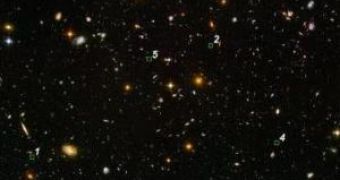Astronomers say that today's huge galaxies are the result of merging small building-block galaxies in the early Universe. Now, they have detected for the first time 9 such "bricks" with the Hubble's Advanced Camera for Surveys and the Near Infrared Camera and Multi-Object Spectrometer.
"These are among the lowest mass galaxies ever directly observed in the early Universe" said Nor Pirzkal of the European Space Agency/STScI.
NASA's Spitzer Space Telescope and Infrared Array Camera and the European Southern Observatory's Infrared Spectrometer and Array Camera were required to make precise measurements of the mass of the newly discovered mini-galaxies, confirming Hubble's observations: these galaxies are some of the smallest building blocks of the Universe, revealing the Universe's cradle years, just one billion years following the Big Bang.
Hubble spotted sapphire blue stars inside the young galaxies. The young stars are just a few million years old and have not yet transformed the Big Bang elements (hydrogen and helium) into heavier ones and they still do not expel around elemental products formed within their nuclei.
"While blue light seen by Hubble shows the presence of young stars, it is the absence of infrared light in the sensitive Spitzer images that was conclusive in showing that these are truly young galaxies without an earlier generation of stars," said co-researcher Sangeeta Malhotra of Arizona State University in Tempe, US.
The discoverers of the galaxies are James Rhoads of Arizona State University, US and Chun Xu of the Shanghai Institute of Technical Physics in Shanghai, China. Three of the new galaxies have an odd not-rounded shape, being stretched into tadpole-like shapes. The researchers believe they have started the process of merging into the large neighboring galaxies.
Investigating such remote and small galaxies is a challenge for the current most powerful telescopes. Images achieved through different color filters with the ACS were combined with grism exposures which spread the various colors expelled by the galaxies into short "trails". The trails' analysis permitted the spotting of emission from glowing hydrogen gas, revealing both the distance and an approximate age for the stars.
The grism exposures were analyzed with software developed at the Space Telescope-European Coordinating Facility in Munich, Germany and enabled the investigation of objects much fainter than can be observed spectroscopically with current telescopes.

 14 DAY TRIAL //
14 DAY TRIAL //